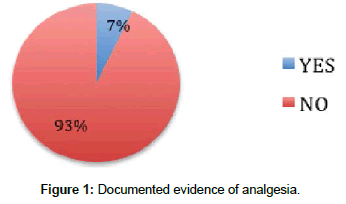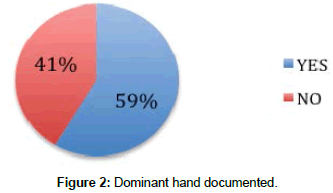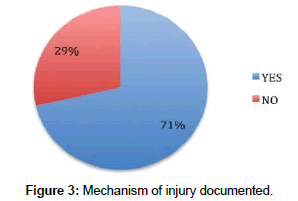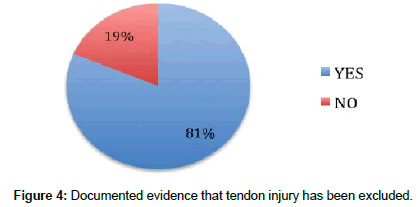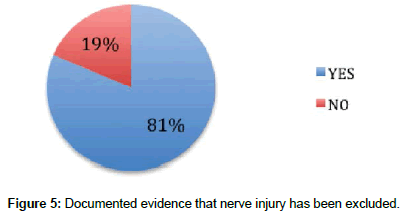Research Article, Clin Res Orthop Vol: 2 Issue: 1
Hand Injury Audit
Okotore OA* and Eyaru E
Department of Emergency medicine, Royal College of Emergency medicine, London, UK
*Corresponding Author : Okotore OA
Department of Emergency medicine, Royal College of Emergency medicine, London, UK
Tel: + 44 (0) 20 7404 1999
E-mail: ladiokotore@yahoo.com
Received: December 29, 2017 Accepted: February 20, 2018 Published: February 27, 2018
Citation: Okotore OA, Eyaru E (2018) Hand Injury Audit. Clin Res Orthop 2:1.
Abstract
Objective: Hand injuries are one of the commonest limb injuries presented to the Emergency Department(ED). The structure and functions are intimately related such that any injury to the underlying structures could cause significant handicap that could be life altering. This audit seeks to explain areas for improvement
in practise and create more awareness of the Royal College of Emergency Medicine (RCEM) standards on hand injuries in the Emergency Department. The RCEM’s standards are documented documented mechanisms of injuries, evidence of analgesia given on presentation to the ED, hand dominance, the exclusion of tendon and nerve injury respectively on clinical examination of hand injuries.
Methods: 70 clinical notes of adult hand injuries presented to the ED between June and December 2014. The cases were randomly selected from the Symphony software(ED data software). There were no exclusion criteria, corresponding ED notes with hand injuries was collected and relevant data was recorded in a predesigned proforma according to the recommendation of the RCEM standards stated above. The data was collated and inputted into a spread sheet and then analysed using Microsoft Excel. The results were then analysed in line with RCEM Standards.
Results: 7% of the notes reviewed had evidence of analgesia given, 59 % documented hand dominance, and 79% documented to mechanism of injury while 81% tendon and nerve injury.
Conclusion: There was a wide variation in the level of compliance with the RCEM standards for hand injuries with compliance being low in three of the five standards reviewed. There is thereby a need to create the awareness of RCEM guidelines on hand injuries and management amongst ED practitioners, to encourage ED
practitioners to document analgesia given in the ED or declined by patients.
Keywords: Hand injury; Analgesia; Hand dominance; Nerve injury; Tendon injury
Introduction & Background
The hand is a unique example of an amazing work of anatomic engineering. Structure and functions are intimately related such that any injury to the underlying structures carries a potential for significant handicap that could be life altering. It is on this premise that a meticulous evaluation of the smallest hand injury needs to be carried out in order to minimise the risk of permanent disability. There is an number of patients presenting with hand injuries to the Emergency Department and this audit aims to review the clinical practice within the Emergency Department towards hand injuries [1].
The Royal College of Emergency Medicine (UK) has set out standards for the management of hand Injuries. These are
• Pain management as per RCEM’s standard
• Dominant hand documented
• Mechanism of injury documented
• Documented evidence that tendon injury was excluded
• Documented evidence that nerve injury was excluded
Aims of the audit
• To assess and identify deficiencies in examination and documentation of hand injuries in the ED of Queens Hospital(BHR University Teaching hospital NHS Trust, Essex, United Kingdom)
• To identify any areas of improvement in practise
• To address areas of improvement by creating more awareness of the RCEM’s standards on hand injuries
Target patient group
Adults with hand injuries
Methodology
A sample size of 70 cases of Adult hand injuries presented to the ED between June 2014 and December 2015 was selected .The cases were randomly selected from the Symphony software(ED data software). There were no exclusion criteria, the corresponding ED notes with hand injuries were reviewed and relevant data recorded in a predesigned proforma that was according to the recommendation of the RCEM guidelines stated above. The data collated and inputted into a spread sheet and then analysed using Microsoft Excel. The results were then analysed in line with RCEM Standards [2-5].
Results
Figure 1 depicts the documented evidence of Analgesia as given to the Emergency Department. Dominant hand and the mechanism of injury were documented as given in Figures 2 and 3.
The evidence mechanism of Injury was documented in 71% of case notes of hand injury analysed; there was 81% compliance in terms of documentary evidence of exclusion of nerve and tendon injury (Figures 4 and 5).
Summary and Conclusion
This study has a number of limitations including a small sample size, the choice of six months for review and the lack of randomization; however, the aim was to find out if there was an awareness of the five RCEM standards for reviewing hand injuries and if these standards were being utilised within the chosen Emergency Department.
There was a wide variation in the level of compliance with the different RCEM standards for hand injuries with compliance being low in three of the five standards. This audit aimed to generate awareness these standard of assessment of hand injuries amongst Emergency Department practitioners in view of the increase in number of hand injuries presented to the Emergency department .The awareness of the RCEM guidelines on hand injuries among ED practitioners and staff should have an impact on the management of these injuries.
Acknowledgement
Audit has been done at Queens Hospital Romford (Barking, Havering and Redbridge University teaching Hospital NHS Trust) Essex, United Kingdom March 2015.
References
- RCEM (2014) Clinical standards for emergency department. College of Emergency Medicine, London, United Kingdom.
- Ellis H (2002) Clinical Anatomy: A Revision and Applied Anatomy for Clinical Students. John Wiley & Sons, New Jersey, United States.
- Kleinert HE,Verdan C (1983) Report of the Committee on Tendon Injuries. J Hand Surg Am 8: 794-798.
- Mullikan RL, Wadman MC (2004) Injuries to the Hand and Digits in Tintinalli in Emergency Medicine. McGraw-Hill, New York, USA.
- Martin DS, Collins ED (1998) Manual of Acute Hand Injuries. Mosby, Philadelphia, USA.
 Spanish
Spanish  Chinese
Chinese  Russian
Russian  German
German  French
French  Japanese
Japanese  Portuguese
Portuguese  Hindi
Hindi 